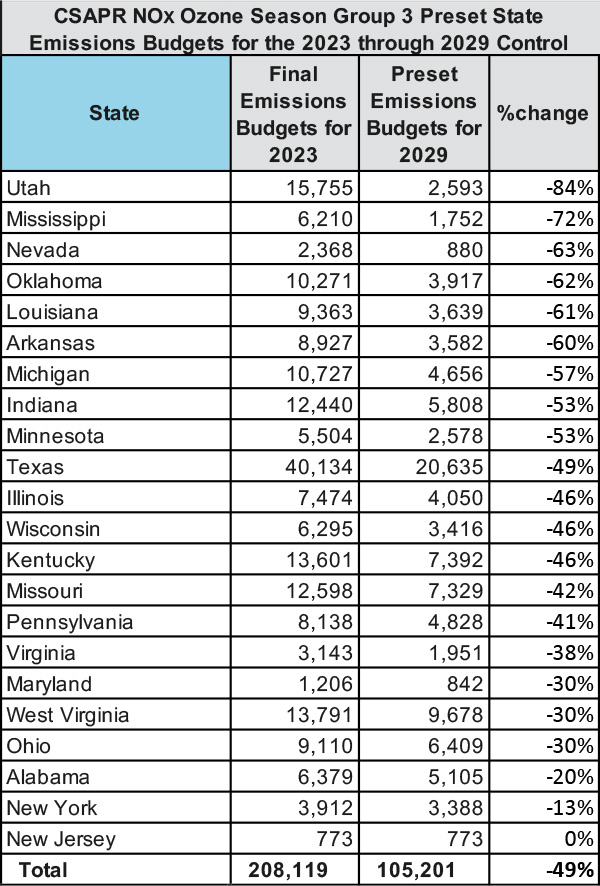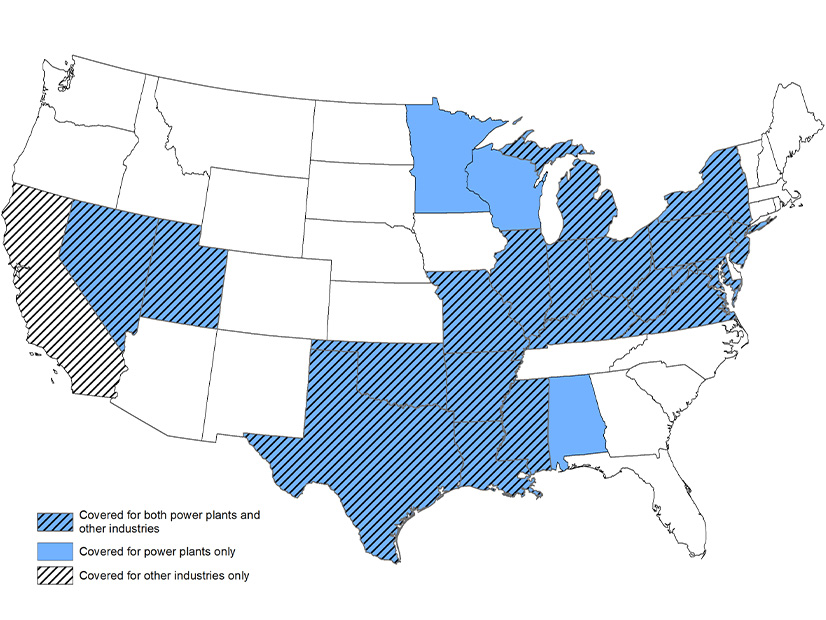EPA on Wednesday announced the final details of its Good Neighbor Plan to slash emissions of smog-forming nitrogen oxides.
The rules will take effect this year and affect power plants and industrial facilities in the 23 states that contribute to unhealthy levels of ground-level ozone in neighboring downwind states, EPA said. It will resolve those states’ obligations under the 2015 National Ambient Air Quality Standards (NAAQS).
The plan includes a revised NOx allowance trading program with gradually decreasing emissions budgets. The 2027 NOx emissions budget for power plants in 22 states during the May 1-Sept. 30 “ozone season” will be 50% lower than the 2021 budget, resulting in significant public health benefits, EPA said.
Revisions to the trading program include features to promote consistent operation of emissions controls, annual recalibration of the emissions allowance bank and annual updates to the emissions budget to reflect changes in the generating fleet.
Also targeted in 20 states are NOx emissions from nine industries: natural gas pipelines; cement kilns; iron/steel/ferroalloy mills; glass furnaces; solid waste incinerators; metal ore mining; chemical manufacturing; petroleum/coal manufacturing; and pulp/paper/paperboard mills.
EPA projects a reduction of 70,000 tons of NOx emissions in 2026: 25,000 from power plants and 45,000 from industry. It also projects a reduction of 16 MMT of carbon dioxide, 29,000 tons of sulfur dioxide and 1,000 tons of fine particle emissions.
The rules drew cheers from environmental activists and warnings from the coal industry about the threat posed to electric resource adequacy and system reliability.
EPA projects that the final rule will result in an additional 14 GW of coal-fired power plant retirements by 2030, some of that through acceleration of shutdowns that had been scheduled after 2030.
 EPA named 22 states with electric generating units (EGUs) linked to downwind air quality problems and said 10 of them will have to reduce their EGU NOx emission budgets by half or more by 2029, with the biggest percentage impacts on Utah (-84%) and Mississippi (-72%). Texas faces the biggest absolute cut, a 49% reduction totaling almost 19,500 tons. | EPA
EPA named 22 states with electric generating units (EGUs) linked to downwind air quality problems and said 10 of them will have to reduce their EGU NOx emission budgets by half or more by 2029, with the biggest percentage impacts on Utah (-84%) and Mississippi (-72%). Texas faces the biggest absolute cut, a 49% reduction totaling almost 19,500 tons. | EPAThe agency also expects the rules will incentivize retrofit of selective catalytic reduction emissions controls on 8 GW of coal power plants. And it expects the rule to accelerate buildout of renewable energy, primarily solar.
Each of the 23 states must submit a State Implementation Plan (SIP) to EPA within three years. If they submit an unacceptable SIP or miss the deadline, EPA will issue a Federal Implementation Plan within two years.
The states haven’t been very successful so far: On Jan. 31, EPA disapproved 19 states’ SIP submissions for the 2015 NAAQS and partially disapproved two other states’ submissions.
EPA said the Good Neighbor Plan provides enough lead time and flexibility that power plant operators can make the necessary changes at reasonable cost without impacting reliability.
But representatives of companies that mine and burn coal voiced concern Wednesday about the impact that the plan will have on the grid at a time when numerous states and the federal government are pushing for increased electrification and use of intermittent resources.
In a statement, the coal power industry group America’s Power said that the rule could “further increase the risks to grid reliability” that it has been warning about.
“Additional coal plant retirements are in stark contrast to the concerns that have been raised by the North American Electric Reliability Corp. and grid operators about the possibility of electricity shortages in many regions of the country caused largely by coal plant retirements,” CEO Michelle Bloodworth said. “Unfortunately, EPA has chosen to reject state plans that would have reduced emissions and avoided reliability problems and, instead, imposed its anti-coal bias on the states and the nation’s electricity supply.”
EPA said that it made several changes to the final rule to address reliability concerns raised by those commenting on the draft.
Among those is deferring “backstop” emission rate requirements for plants that do not have state-of-the-art controls until 2030, allowing power plant operators to “bank” allowances at a higher level through 2030 and establishing a “predictable minimum quantity of allowances available through 2029.”
PJM welcomed those changes.
“PJM worked extensively with other affected RTOs and EPA to address our reliability concerns with the rule as originally proposed,” it told RTO Insider via email. “We are encouraged by the changes that EPA has made and their indication of a willingness to develop various mechanisms to ensure the adequate availability of allowances to meet reliability needs. We intend to work closely with EPA and stakeholders to further the development of these reliability safety valve mechanisms to accompany the Good Neighbor Rule.”
The National Mining Association was not mollified.
“The nation’s grid regulators and operators have repeatedly warned EPA that its regulatory plans pose an ominous threat to reliability, and the EPA’s response is to paper over the problem with meaningless memorandums of understanding,” the group stated. “Intermittent renewable power additions will require a massive expansion of transmission infrastructure and energy storage — an effort that will take years to complete — in order to fill the gulf left by coal plant retirements. In fact, in 2022, as many as 40 planned coal plant retirements were postponed or scrapped largely due to acute grid reliability challenges where utilities and grid operators have made it clear closing plants would be reckless.”
NERC has flagged reliability as an increasing concern, particularly from severe weather and increasing use of variable power generation. (See NERC Warns of Ongoing Extreme Weather Risks.)
“NERC has not done a specific analysis of the Good Neighbor Rule but recognizes that to assure reliability during the energy transformation, the pace of change must occur in an orderly and managed way, with flexibility to maintain generating units that are needed for reliability,” the ERO said via email. “NERC’s Long-Term Reliability Assessment examines the reliability implications of the changing resource mix, including the cumulative impacts of policies that are driving the transformation such as the Good Neighbor Rule.”
The rule is the latest in a long series of regulatory constraints on emissions from power plants, particularly those that burn coal. Already this year EPA has proposed tighter rules on wastewater discharge from coal plants and reaffirmed the Mercury and Air Toxic Standards for coal and oil plants. (See EPA Proposes Tighter Coal Plant Wastewater Regs and EPA Reaffirms Power Plant Mercury Regulations.)
The agency has framed the Good Neighbor Plan as a tool for public health and environmental justice. It said that in 2026 alone it expected the tighter emissions standards to prevent approximately 1,300 premature deaths, more than 2,300 hospital visits, 1.3 million asthma attacks, 430,000 school-day absences and 25,000 lost workdays.
It estimated the annual net benefit at $13 billion a year through 2042, not counting intangibles such as ecosystem improvements.
“We know air pollution doesn’t stop at the state line,” EPA Administrator Michael Regan said in a statement. “Today’s action will help our state partners meet stronger air quality health standards beyond borders, saving lives and improving public health in impacted communities across the United States.”
The Sierra Club hailed the announcement.
“Last summer, over 70,000 people shared their support for the Good Neighbor Plan, demanding fossil fuel power plants and industrial facilities that are polluting communities … comply with strict air quality standards,” said Leslie Fields, Sierra Club’s policy, advocacy and legal director. “We are pleased EPA is listening to the people it serves and finalizing this common-sense solution to dangerous interstate ozone pollution.”
The 23 states affected by the rule are:
-
-
- industrial emissions only: California.
- power plant emissions only: Alabama, Minnesota, Wisconsin.
- both: Arkansas, Illinois, Indiana, Kentucky, Louisiana, Maryland, Michigan, Mississippi, Missouri, Nevada, New Jersey, New York, Ohio, Oklahoma, Pennsylvania, Texas, Utah, Virginia and West Virginia.
-
But the list may change. In a fact sheet, EPA said its updated modeling analysis showed that Arizona, Iowa, Kansas and New Mexico may be significantly contributing to ozone pollution in downwind states. It plans to undertake additional analysis to determine if they should be subject to Good Neighbor obligations.
The same updated modeling indicated Delaware is not significantly contributing to downwind pollution, so EPA withdrew its proposed Good Neighbor Plan for that state.
EPA is deferring action on Tennessee and Wyoming pending further review of the updated modeling.




